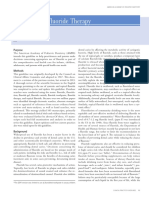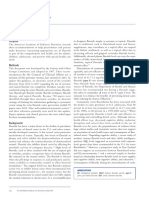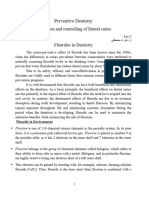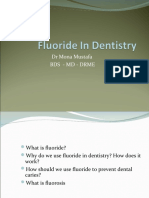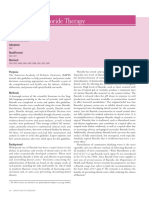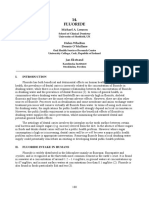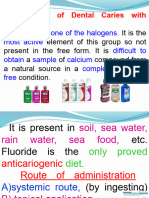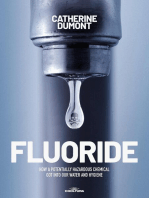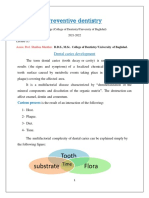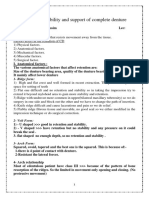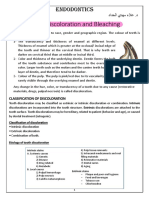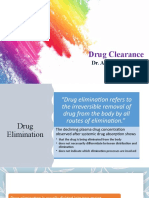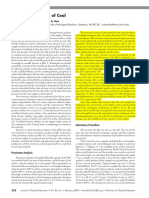Professional Documents
Culture Documents
Appendices
Appendices
Uploaded by
ريام الموسويOriginal Description:
Copyright
Available Formats
Share this document
Did you find this document useful?
Is this content inappropriate?
Report this DocumentCopyright:
Available Formats
Appendices
Appendices
Uploaded by
ريام الموسويCopyright:
Available Formats
Appendices ﻣﻼﺣﻖ ﻣﺤﺎﺿﺮﺍﺕ ﺍﻟﻔﻠﻮﺭﺍﻳﺪ ﺍﻟﺴﺘﺔ
Lec 4 Fluoride and dental caries:
1- Fluoride: is the term used when fluorine is combined chemically
with a positively charged counterpart.
2- The presence of Ca may lead to formation of insoluble salts
with fluoride and absorption reduced to 70% and in food rich
with Ca to 60%.
3- Fluoride in Plasma: Plasma is the biological fluid into which
and from which fluoride must pass for its distribution elsewhere
in the body and for its elimination from the body.
- The concentration of ionic fluoride in soft and hard tissue is
directly related to the amount of ionic fluoride intake.
- Fluoride balance in infants can be positive or negative during
the early months of life, depending on whether intake is
sufficient to maintain the plasma concentration that existed
at the time of birth.
- The intracellular fluoride concentrations are from 10–50
% lower than those of plasma, but they change
simultaneously and in proportion to those of plasma.
- The tissue-to-plasma ratios of radioactive fluoride are
consistent with the hypothesis that hydrogen fluoride (HF)
is the form in which fluoride migrates and establishes
diffusion equilibrium across cell membranes.
- Since the pH gradient across the membranes of most cells
can be decreased or increased by altering extracellular pH, it
is possible to promote the net flux of fluoride into or out of
cells. This is the basis for the suggestion that alkalinization
of the body fluids is a useful adjunct in the treatment of
acute fluoride toxicity.
4- Dentine and bone appear to have similar fluoride
concentrations which increase with age, while that of enamel
is markedly lower. Surface enamel fluoride concentrations tend
to decrease with age in areas subjected to tooth wear but
increase in areas that accumulate plaque.
5- In Sweat Usually, only a few percent of the fluoride intake is
excreted in the sweat. However, under excessive sweating as
much as 50 percent of the total fluoride excreted may be lost via
perspiration.
6- In Saliva Less than 1 percent of absorbed fluoride is reported
to appear in the saliva. The concentration of fluoride in saliva
is about two-thirds of the plasma fluoride concentration and
seems to be independent of flow rate, in contrast to the
situation for most electrolytes. In fact, saliva does not represent
true excretion, because most of the fluoride will be recycled in
the body.
Lec. 5-6 Systemic fluoridation
Dental fluorosis: Infants and toddlers are especially at risk for
dental fluorosis of the anterior teeth since it is during the first 3
years of life that the permanent front teeth are the most sensitive to
the effects of fluoride (The central incisor takes approximately 3
years to go through complete enamel mineralization.
- Fluoride accumulates at the transition/ maturation stage of
tooth development so that the entire tooth surface can be
affected.
- Children fed formula made with fluoridated water are at
higher risk to develop dental fluorosis.
1. Child from birth -3year takes excess fluoride from tap water
used for infant formula, Incisors, and first molars are most affected
teeth.
2. Child from 3–6 years takes excess fluoride from early
toothpaste use, premolars, canines and second molars are most
affected teeth.
3. Child from 0-6years takes excess fluoride from
Fluoride supplements and fluoridated water (drinking water
>4 ppm fluoride), all teeth affected.
- A direct relationship is present between dental fluorosis and
level of F ingested.
- The severity of dental fluorosis depend on:
1. Stage of tooth development.
2. Duration of exposure to fluoride.
3. Concentration of fluoride in foods and drinks.
- The earliest sign is a change in color, showing many thin
white horizontal lines running across the surfaces of the
teeth, with white opacities at the newly erupted incisal end.
The white lines run along the ‘perikymata’, a term
referring to transverse ridges on the surface of the tooth,
which correspond to the incremental lines in the enamel
known as Striae of Retzius.
- Dental fluorosis is related to physiological conditions,
including body weight, rate of skeletal growth and
remodeling, nutrition, and renal function.
- It is widely known that F- affects the kinetics of
bio mineralization, triggering the incomplete mineralization
of enamel crystals and producing porous enamel-which is
typical of dental fluorosis.
- Bone is a reservoir of fluoride, as fluoride is incorporated
in the forming apatite crystals, and this ion can also be
released from these crystals as bone remodels. Therefore,
rapid bone growth, as occurs in the growing child, will
remove fluoride from the blood stream, possibly reducing
the risk of dental fluorosis by lowering serum fluoride
levels.
- Treatment of Dental Fluorosis:
Type of fluorosis Treatment
Mild bleaching, to make the color of the
tooth surface uniform
Moderate Composite restorations combined
with micro abrasion or application
of aesthetic veneers
Sever prosthetic crowns
- Incipient Caries and Fluorosis Diagnosis: It is important
to differentiate visually between incipient caries and
developmental white spot hypocalcifications (fluorosis) of
enamel.
1- Dental fluorosis is common to observe and is unaffected
by drying and wetting. So, a white spot that is an
incipient lesion will disappear upon wetting and a
hypocalcification will remain whether dry or moist.
2- White spot carious lesions usually occur around
margins of gingival (the favorable site for plaque
deposition).
Water fluoridation:
- The National Advisory Committee on Oral Health
suggested a range 0.6-1.1 mg/L with variation within that
range according to the mean maximum daily temperature.
- Advantages of water fluoridation:
- 1- Low cost.
-2- No motivation or behavioral changes necessary.
- 3- Had pre and post eruptive benefit.
-4- Caries reduction 50-60% in permanent teeth, and 40-
50% in primary teeth. And the disadvantage is the
possibility of mild to moderate fluorosis
.
- Disadvantages of water fluoridation
1- Political and/or emotional objections to water additives.
2- Possibility of mild to moderate fluorosis if other sources
of fluoride are ingested
3- Alleged,toxicity.
- In recent years there have been attempte to link
fluoridation with a wide range of diseases, e.g. cancer,
Alzheimer diseases or that it interferes with the immune
function. But there is overwhelming agreement between the
scientific, medical and dental community worldwide that
fluoridation of water is a safe and effective public health
measure.
Fluoride Supplements:
- Fluoride supplement is daily used from 6months to 16 years
to give their maximum effect (To obtain the benefits from
fluoride supplements, long-term compliance on a daily basis
is required).
- To maximize the topical effect of fluoride, tablets and
lozenges are intended to be chewed or sucked for 1–2
minutes before being swallowed.
- Advantages and disadvantages of F salts:
Advantages:
-Wide coverage
-Need little action by the individual
- Low coast
- Freedom for the consumers as both fluoridated and non-
fluoridated salt is available
- It is safe
- Minimum possibilities of fluorosis.
- Fluoridated milk
Disadvantages:
-Consumption of milk varies between different
socioeconomic groups.
-Consumption decrease with age so long term benefit is less
than water fluoridation
-Require high level of technical expertise.
–A high concentration of fluoride is needed for two reasons:
(1) the children did not drink the beverage throughout the
day.
(2) calcium in the milk complexes with fluoride, which
would reduce its availability for topical benefits
Disadvantages:
-Salt fluoridation need community education and
promotion.
-International efforts to reduce sodium intake to
help control hypertension.
- Consumption of fluoridated salt is lowered during early
life when the need for fluoride is the maximum.
- Lec 7- 8 Topical fluoride
- Advantages of topical fluoride:
. -Does not cause fluorosis.
. -Cariostatic for people of all ages.
. -Available only to people who desire it.
. -Easy to use.
Disadvantages of topical fluoride:
.- Person must remember to use.
.- High cost compared to water fluoridation.
- More concentrated professional use products can cause short-term side
effects like nausea immediately after use.
- The efficacy of topical fluoride depends on:
a. The concentration of fluoride used.
b. The frequency with which it is applied and the duration of application.
c. The specific fluoride compound used.
- Commonly used topical fluoride agents include: Sodium fluoride,
Sodium monofluorophosphate. Stannous fluoride and Amine fluoride.
- Goals of topical Fluoride (F) Administration
- .Do not harm the patient.
. -Prevent decay on intact dental surfaces.
.- Arrest active decay.
-Remineralize decalcified tooth surfaces
-Requisites for self-applied fluoride agents: [community and
individuals:
- Should be completely safe.
- Should be effective for preventing caries.
- Method should be suitable for use by large groups and
at a reasonably low cost.
- Should be acceptable to participants.
- Should be easy to use to ensure compliance.
- Should require few professional personnel.
- Should be able to be supervised by non-dental
personnel after short periods of in-service training.
- Most toothpaste nowadays contain sodium fluoride or sodium
monofluorophosphate as active ingredient, usually in concentration of
1000–1100 mg F/g.
- Most 1000 ppm fluoride containing toothpaste achieve this
concentration, i.e.
%0.1]F= 1 mgF/g paste] by adding one of the following fluoride salts.
Sodium fluoride 0.2% NaF
Sodium monofluorophosphate 0.76% Na2PO3F
Stannous fluoride [0.4% SnF2]
- Fluoride in toothpaste is taken up directly by demineralized
enamel and it also increases the fluoride concentration in
dental plaque, thus leaving a store of fluoride available for
remineralization when pH drops.
- For reasons of lowest expense, convenience in handling as
well avoidance of unpleasant taste, NaF became the most
widely used of these tested products in public health
programs
- The combination programs between systemic and topical
fluoridation may give about 75% reduction in dental caries.
- Advantages of F varnishes:
1- The use of fluoride varnish increases the fluoride
concentration in
saliva, which remains significantly higher 2 hours
after its application than after the use of other fluoride
agents.
. - 2 Simple application and requires minimal training.
. 3Prolonged contact time between fluoride and the tooth
surfaces (increases fluoride uptake by dental hard tissues, as
well as the formation of CaF2 reservoirs), and the possibility
of using very small amounts of the product (a thin layer),
which minimizes the risk of
excessive fluoride ingestion.
- Fluoride containing restorative materials includes glass
ionomer cements, resin modified glass ionomer cements,
polyacid modified resin composites (compomers), resin
composites, fissure sealants and dental amalgam .Fluoride
releasing components have included fluoroaluminosilicate
glasses (FAG), stannous fluoride (SnF2), organic amine
fluorides (CAFH) and ytterbium fluoride (YbF).
- There are three types of slow-release F devices: the
copolymer membrane type, developed in the United States,
and the glass bead, developed in the United Kingdom. More
recently, a third type, which consists in a mixture of sodium
fluoride (NaF) and hydroxyapatite.
Lec 9 Fluoride toxicity:
- Factors affecting fluoride toxicity: The differences in toxic
potential of different fluoride compounds are related to:
- .1Solubility of the compound.
- .2 Content of the compound, e.g. stannous fluoride is
slightly more toxic than sodium fluoride because high doses
of tin ion.
- . 3route of administration
- . 4Age.
- .5Rate of absorption.
- 6. Acid-base status.
- Table (1): Effect of fluoride in water on
human health when consumed for longer
durations
Fluoride concentration (mg/L) Effects
<1.0 Safe limit
1.0–3.0 Dental Fluorosis
3.0–4.0 Brittle and stiff bones and joints
4.0–10 Dental fluorosis, skeletal fluorosis
(pain in neck bones and back)
You might also like
- Systemic FluorideDocument7 pagesSystemic FluoridemaryamfaidelNo ratings yet
- Lec 9 PDFDocument7 pagesLec 9 PDFFlorida ManNo ratings yet
- Fluoride: Nature's Cavity FighterDocument11 pagesFluoride: Nature's Cavity FighterAya OsamaNo ratings yet
- 1.1 BackgroundDocument43 pages1.1 Backgroundகாளையின் காதலன்No ratings yet
- FluoridesDocument54 pagesFluoridesNAUMAN SHAHNo ratings yet
- Fluoride ApplicationsDocument5 pagesFluoride ApplicationsfatemasameeraliredaNo ratings yet
- Flourides and FluoridationDocument38 pagesFlourides and FluoridationmisdduaaNo ratings yet
- Preventive DentistryDocument7 pagesPreventive DentistryAyad IbrahimNo ratings yet
- Flouride in Dentistry by Ammar MohammedDocument10 pagesFlouride in Dentistry by Ammar Mohammedعمار محمد عباسNo ratings yet
- Dr. Ali Fahad Al-Fatlawi Community Dentistry LEC: 6Document3 pagesDr. Ali Fahad Al-Fatlawi Community Dentistry LEC: 6مؤمل رياض سعد كاظمNo ratings yet
- Anticaries AgentsDocument12 pagesAnticaries AgentsHridoyul IslamNo ratings yet
- Fluoride ApplicationDocument14 pagesFluoride ApplicationsmhhjjyNo ratings yet
- UntitledDocument19 pagesUntitledArtemisisNo ratings yet
- Systemic Water Fluoridation IncludeDocument6 pagesSystemic Water Fluoridation IncludeFlorida ManNo ratings yet
- Notes - Preventive Dentistry Topic 4 - Introduction To FluorideDocument15 pagesNotes - Preventive Dentistry Topic 4 - Introduction To Fluoridegigibis2No ratings yet
- PS 2 2 1 FluorideUse - FCDocument6 pagesPS 2 2 1 FluorideUse - FCKaran AroraNo ratings yet
- 03 Ibtw Lecture 10 PDFDocument9 pages03 Ibtw Lecture 10 PDFgreen1458No ratings yet
- Fluoride in Dentistry: DR Mona Mustafa Bds - MDDocument61 pagesFluoride in Dentistry: DR Mona Mustafa Bds - MDTasneem DakkakNo ratings yet
- Fluoride and Fluoridation: Topical FluoridesDocument3 pagesFluoride and Fluoridation: Topical FluoridesmarkoNo ratings yet
- Dental Fluorosis and Its PreventionDocument4 pagesDental Fluorosis and Its PreventionSachinSharmaNo ratings yet
- Fluoridated Hydroxyapatite (Ca (PO) (OH) F), Where X Is Much SmallerDocument36 pagesFluoridated Hydroxyapatite (Ca (PO) (OH) F), Where X Is Much SmallerDrBhawna AroraNo ratings yet
- Guideline On Fluoride Therapy: Review Council Latest RevisionDocument4 pagesGuideline On Fluoride Therapy: Review Council Latest RevisionThesya Aulia GeovanyNo ratings yet
- Wisconsin Department of Health Services Division of Public Health Oral Health Program P. O. Box 2659 Madison, WI 53701-2659Document2 pagesWisconsin Department of Health Services Division of Public Health Oral Health Program P. O. Box 2659 Madison, WI 53701-2659Foysal SirazeeNo ratings yet
- BP FluorideTherapyDocument4 pagesBP FluorideTherapyKavana SrinivasNo ratings yet
- Prevention and Controlling of Dental Caries: Preventive DentistryDocument6 pagesPrevention and Controlling of Dental Caries: Preventive Dentistryreyamsalam2000No ratings yet
- 1 ADA Fluoride - UseDocument5 pages1 ADA Fluoride - UseTalat SultanaNo ratings yet
- Topikal Aplikasi FluorDocument7 pagesTopikal Aplikasi FluorYessy Natalia NataliaNo ratings yet
- FluoriosisDocument73 pagesFluoriosisnathanielge19No ratings yet
- A Review On Effect of Fluoride Concentration in Drinking Water.Document4 pagesA Review On Effect of Fluoride Concentration in Drinking Water.Anonymous HXZigeNo ratings yet
- Fluorides in Dentistry: Dental Caries Prevention and ControlDocument5 pagesFluorides in Dentistry: Dental Caries Prevention and ControlFlorida ManNo ratings yet
- Fluorides in Caries Prevention: Vian Al-JafDocument54 pagesFluorides in Caries Prevention: Vian Al-JafShanaz ShaxawanNo ratings yet
- 10 Fluoride 2Document70 pages10 Fluoride 2KK AgarwallNo ratings yet
- Fluoride and Public Health: The Irish Expert Body On Fluorides and HealthDocument6 pagesFluoride and Public Health: The Irish Expert Body On Fluorides and HealthRizka aulianaNo ratings yet
- Dental Fluorosis and Its PreventionDocument53 pagesDental Fluorosis and Its Preventiontaramaher7No ratings yet
- Fluoride Lec 3 PDFDocument5 pagesFluoride Lec 3 PDFRick SanchezNo ratings yet
- TOXICITY of FLOURIDESDocument45 pagesTOXICITY of FLOURIDESNavneet KaurNo ratings yet
- Fluorides: Studentica: Dora Maršanić Kolegij: Engleski Jezik Voditelj Kolegija: Doc. Dr. Sc. Arijana Krišković, ProfDocument27 pagesFluorides: Studentica: Dora Maršanić Kolegij: Engleski Jezik Voditelj Kolegija: Doc. Dr. Sc. Arijana Krišković, ProfBokiNo ratings yet
- Articulo 2Document6 pagesArticulo 2Alexander RuizNo ratings yet
- Fluoride Therapy: Latest RevisionDocument4 pagesFluoride Therapy: Latest RevisionLaura ZahariaNo ratings yet
- DR Mona Mustafa Bds - MD - DrmeDocument58 pagesDR Mona Mustafa Bds - MD - Drmeعبدالمحسن العيسىNo ratings yet
- Role of Floride in Dentistry - Global PerspectiveDocument10 pagesRole of Floride in Dentistry - Global PerspectiveZainabNo ratings yet
- Dental FluorosisDocument5 pagesDental FluorosisAbdullah EhsanNo ratings yet
- Dental FluorosisDocument70 pagesDental Fluorosiskaran89No ratings yet
- (Fluoride in Dentistry) : Prevention and Controlling of Dental CariesDocument32 pages(Fluoride in Dentistry) : Prevention and Controlling of Dental Cariesفواز نميرNo ratings yet
- Water Fluoridation: Fluoridation Methods Used in Dental Caries PreventionDocument2 pagesWater Fluoridation: Fluoridation Methods Used in Dental Caries PreventionEdralene AntoyNo ratings yet
- FluorideDocument50 pagesFluoriderajshreeNo ratings yet
- Fluoride ExpoDocument6 pagesFluoride ExpoNeutron ZionNo ratings yet
- National Programme For Prevention and Control of FluorosisDocument49 pagesNational Programme For Prevention and Control of FluorosisveereshNo ratings yet
- Who Ced PheDocument8 pagesWho Ced PheMuhammad RizwanNo ratings yet
- G Fluoridetherapy PDFDocument4 pagesG Fluoridetherapy PDFChandrika VeerareddyNo ratings yet
- G Fluoridetherapy PDFDocument4 pagesG Fluoridetherapy PDFmirfanulhaqNo ratings yet
- 03 PDFDocument5 pages03 PDFayuNo ratings yet
- Manju Arora PDFDocument8 pagesManju Arora PDFSunil ChandraNo ratings yet
- 2017 - Curse of FluorosisDocument9 pages2017 - Curse of FluorosisjaynajNo ratings yet
- 2011 DenBesten Revisión de EtiopatogeniaDocument23 pages2011 DenBesten Revisión de EtiopatogeniaKAREN ANAIS URGILES ESPINOZANo ratings yet
- Fluoride Releasing Restorative MaterialsDocument23 pagesFluoride Releasing Restorative MaterialsDr. Nikhil saran100% (1)
- 3 FluorideDocument26 pages3 Fluoridemrbyy619No ratings yet
- Fluoride I Moodle 2011Document11 pagesFluoride I Moodle 2011noorNo ratings yet
- A Comprehensive Review of Rapid Palatal Expansion and Mini-Screw Assisted Rapid Palatal ExpansionDocument6 pagesA Comprehensive Review of Rapid Palatal Expansion and Mini-Screw Assisted Rapid Palatal Expansionريام الموسويNo ratings yet
- Lip DiseasesDocument13 pagesLip Diseasesريام الموسويNo ratings yet
- Emergencies of Dental PracticeDocument25 pagesEmergencies of Dental Practiceريام الموسويNo ratings yet
- Effects of Fixed Retainers On Gingival RecessionDocument6 pagesEffects of Fixed Retainers On Gingival Recessionريام الموسويNo ratings yet
- 3D RmeDocument10 pages3D Rmeريام الموسويNo ratings yet
- Jco - 2005 03 155Document14 pagesJco - 2005 03 155ريام الموسويNo ratings yet
- RMECERCHIDocument5 pagesRMECERCHIريام الموسويNo ratings yet
- l51482 Copy 150416082242 Conversion Gate02Document6 pagesl51482 Copy 150416082242 Conversion Gate02ريام الموسويNo ratings yet
- Gingival Labial Recessions and The Post-Treatment Proclination of Mandibular IncisorsDocument7 pagesGingival Labial Recessions and The Post-Treatment Proclination of Mandibular Incisorsريام الموسويNo ratings yet
- All About STANDARD BRACES Stainless SteelDocument1 pageAll About STANDARD BRACES Stainless Steelريام الموسويNo ratings yet
- Differential Diagnosis and ManagementDocument78 pagesDifferential Diagnosis and Managementريام الموسويNo ratings yet
- Gummysmile 210517040945Document135 pagesGummysmile 210517040945ريام الموسويNo ratings yet
- ArticolopdfminervaDocument14 pagesArticolopdfminervaريام الموسويNo ratings yet
- Gummy Smile and Its Management: Review ArticleDocument8 pagesGummy Smile and Its Management: Review Articleريام الموسويNo ratings yet
- Evaluation of The Effect of Removable Maxillary ExDocument6 pagesEvaluation of The Effect of Removable Maxillary Exريام الموسويNo ratings yet
- All About The FIXED PENDULUM APPLIANCE FPADocument1 pageAll About The FIXED PENDULUM APPLIANCE FPAريام الموسويNo ratings yet
- E1 MJAFImaxexpansionusingquadhelixinclp2009Document5 pagesE1 MJAFImaxexpansionusingquadhelixinclp2009ريام الموسويNo ratings yet
- All About The ESSIX APPLIANCE RetainerDocument1 pageAll About The ESSIX APPLIANCE Retainerريام الموسويNo ratings yet
- All About The REMOVABLE PALATAL EXPANSION APPLIANCE KDEDocument1 pageAll About The REMOVABLE PALATAL EXPANSION APPLIANCE KDEريام الموسويNo ratings yet
- Show Infetious Diseases IDocument18 pagesShow Infetious Diseases Iريام الموسويNo ratings yet
- Prevention Lec.1 Introduction (DR - Cube)Document35 pagesPrevention Lec.1 Introduction (DR - Cube)ريام الموسويNo ratings yet
- All About SeparatorsDocument1 pageAll About Separatorsريام الموسويNo ratings yet
- Oral Surg. Lec.1 (Maxillofacial Trauma)Document39 pagesOral Surg. Lec.1 (Maxillofacial Trauma)ريام الموسويNo ratings yet
- Pros Lec 1Document15 pagesPros Lec 1ريام الموسويNo ratings yet
- Preven Lec 2Document7 pagesPreven Lec 2ريام الموسويNo ratings yet
- Retention and Stability of Complete DentureDocument11 pagesRetention and Stability of Complete Dentureريام الموسويNo ratings yet
- Dental Caries DevelopmentDocument8 pagesDental Caries Developmentريام الموسويNo ratings yet
- Endodontics Pain Control in Endodontics: Differential Diagnosis of Dental PainDocument4 pagesEndodontics Pain Control in Endodontics: Differential Diagnosis of Dental Painريام الموسويNo ratings yet
- Discoloration of TeethDocument5 pagesDiscoloration of Teethريام الموسويNo ratings yet
- Developmental Soft TissueDocument31 pagesDevelopmental Soft Tissueريام الموسويNo ratings yet
- Powerpoint On Henna LeavesDocument10 pagesPowerpoint On Henna LeavesloloayungNo ratings yet
- LuminUltra QG21W Test Kit Instructions ENDocument13 pagesLuminUltra QG21W Test Kit Instructions ENCrisnuel RamirezNo ratings yet
- Kingspan PIR Datasheet King Zip Roof July 2020Document10 pagesKingspan PIR Datasheet King Zip Roof July 2020Georgios PNo ratings yet
- Chap 5 ShortDocument43 pagesChap 5 Shortsheikh muhammad mubashirNo ratings yet
- Dump Valves DVU Series: FeaturesDocument2 pagesDump Valves DVU Series: FeaturesalopezvillavicencioNo ratings yet
- Application of PesticideDocument35 pagesApplication of PesticideashanNo ratings yet
- Microbes in Human Welfare Dpp1Document45 pagesMicrobes in Human Welfare Dpp1AdityaNo ratings yet
- 1 s2.0 S1749772817300854 MainDocument9 pages1 s2.0 S1749772817300854 Mainsally.marshNo ratings yet
- Masteremaco N 303 - KsaDocument2 pagesMasteremaco N 303 - KsaSaadNo ratings yet
- Paper BatteryDocument12 pagesPaper BatteryNiranjanShettyNiruNo ratings yet
- Answer All Questions in This Section. Indicate The Correct Answer On The Space Provided in Page 3Document5 pagesAnswer All Questions in This Section. Indicate The Correct Answer On The Space Provided in Page 3sean0% (1)
- Naming Ionic CompoundsDocument6 pagesNaming Ionic CompoundsMary Jane YepesNo ratings yet
- Singeing: It's Sk'sDocument28 pagesSingeing: It's Sk'saqsa imranNo ratings yet
- Drug Study: West Visayas State University La Paz, Iloilo CityDocument3 pagesDrug Study: West Visayas State University La Paz, Iloilo CityBALOGO TRISHA MARIENo ratings yet
- HMP50 Temperature and Relative Humidity Probe: Revision: 10/09Document20 pagesHMP50 Temperature and Relative Humidity Probe: Revision: 10/09ムリーリョベラスケスローニNo ratings yet
- 119 02695 01 Low Streaking Hard Surface CleanerDocument1 page119 02695 01 Low Streaking Hard Surface Cleanerralina milyaniNo ratings yet
- Quiz 1A: Chemistry 123 Harwood/Fall 05Document2 pagesQuiz 1A: Chemistry 123 Harwood/Fall 05216435964No ratings yet
- Methylamine RecipeDocument4 pagesMethylamine RecipeVanilla470% (1)
- Research Chemistry 1819Document19 pagesResearch Chemistry 1819CrazyGamer 14738No ratings yet
- Chlorine Tree PDFDocument2 pagesChlorine Tree PDFRenzo Flores GomezNo ratings yet
- Rucha Bafna NDPS 1182190023Document27 pagesRucha Bafna NDPS 1182190023rucha bafnaNo ratings yet
- Worksheet Class-Ix CHAPTER - 1, Cell A. Give Reasons, WhyDocument3 pagesWorksheet Class-Ix CHAPTER - 1, Cell A. Give Reasons, WhyDHRUV .C.K.No ratings yet
- Synthesis and Characterization of Strongly Fluorescent Europium-Doped Calcium Sulfide NanoparticlesDocument5 pagesSynthesis and Characterization of Strongly Fluorescent Europium-Doped Calcium Sulfide NanoparticleszahidNo ratings yet
- Proximate Analysis of CoalDocument3 pagesProximate Analysis of CoalBrandeice BarrettNo ratings yet
- Tablets MCQsDocument5 pagesTablets MCQsAl-Homam SalahNo ratings yet
- A Synthesis of Vitamin B6Document4 pagesA Synthesis of Vitamin B6Eric JagerNo ratings yet
- Tanzania Audits Final Report (Workstations SGS MWANZA) PDFDocument18 pagesTanzania Audits Final Report (Workstations SGS MWANZA) PDFRegina EfraimNo ratings yet
- Lab Evaluation Result of OPP Lam White and Flexilam Inks Using Mixed EVA and CLPP Resin From Different Supplier.Document1 pageLab Evaluation Result of OPP Lam White and Flexilam Inks Using Mixed EVA and CLPP Resin From Different Supplier.All About OszNo ratings yet
- GMP and Haccp Handbook For Small and Medium Scale PDFDocument83 pagesGMP and Haccp Handbook For Small and Medium Scale PDFAna Caroline FerroNo ratings yet
- D392002424 MKT 001 PDFDocument2 pagesD392002424 MKT 001 PDFfajarulmNo ratings yet





















